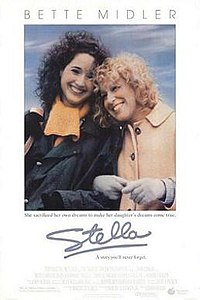Stella (1990) Full Movie HD in Dubbed Dual Audio Watch Online

Plot Summary:
Although
the start of the history of film is not clearly defined, the
commercial, public screening of ten of Lumière brothers' short films in
Paris on 28 December 1895 can be regarded as the breakthrough of
projected cinematographic motion pictures. There had been earlier
cinematographic results and screenings but these lacked either the
quality or the momentum that propelled the cinématographe Lumière into a
worldwide success.
Soon film production companies were established all over the world. The first decade of motion picture saw film moving from a novelty to an established mass entertainment industry.The earliest films were in black and white, under a minute long and without recorded sound.During the 1890s films became several minutes long and started to consist of several shots. The first film studios were built in 1897. The first rotating camera for taking panning shots was built in 1898. Special effects were introduced and film continuity, involving action moving from one sequence into another, began to be used.
In the 1900s, continuity of action across successive shots was achieved and the first close-up shot was introduced (some claim D. W. Griffith was the inventor). Most films of this period were what came to be called "chase films". The first successful permanent theatre showing only films was "The Nickelodeon" in Pittsburgh in 1905. The first feature length multi-reel film was a 1906 Australian production. By 1910, actors began to receive screen credit for their roles, opening the way for the creation of film stars. Regular newsreels were exhibited from 1910 and soon became a popular way for finding out the news. From about 1910, American films had the largest share of the market in Australia and in all European countries except France.
New film techniques were introduced in this period including the use of artificial lighting, fire effects and low-key lighting (i.e. lighting in which most of the frame is dark) for enhanced atmosphere during sinister scenes. As films grew longer, specialist writers were employed to simplify more complex stories derived from novels or plays into a form that could be contained on one reel and be easier to be understood by the audience – an audience that was new to this form of storytelling. Genres began to be used as categories; the main division was into comedy and drama but these categories were further subdivided. During the First World War there was a complex transition for the film industry. The exhibition of films changed from short one-reel programs to feature films. Exhibition venues became larger and began charging higher prices. By 1914, continuity cinema was the established mode of commercial cinema. One of the advanced continuity techniques involved an accurate and smooth transition from one shot to another.
D. W. Griffith had the highest standing among American directors in the industry, because of the dramatic excitement he conveyed to the audience through his films. The American film industry, or "Hollywood", as it was becoming known after its new geographical center in Hollywood, a neighborhood in Los Angeles, California, gained the position it has held, more or less, ever since: film factory for the world and exporting its product to most countries. By the 1920s, the United States reached what is still its era of greatest-ever output, producing an average of 800 feature films annually,[1] or 82% of the global total (Eyman, 1997). During late 1927, Warner's released The Jazz Singer, with the first synchronized dialogue (and singing) in a feature film. By the end of 1929, Hollywood was almost all-talkie, with several competing sound systems (soon to be standardized). Sound saved the Hollywood studio system in the face of the Great Depression (Parkinson, 1995).
The desire for wartime propaganda created a renaissance in the film industry in Britain, with realistic war dramas. The onset of American involvement in World War II also brought a proliferation of films as both patriotism and propaganda. The House Un-American Activities Committee investigated Hollywood in the early 1950s. During the immediate post-war years the cinematic industry was also threatened by television and the increasing popularity of the medium meant that some film theatres would bankrupt and close. The 1950s was considered a "Golden Age" for non-English cinema.
Soon film production companies were established all over the world. The first decade of motion picture saw film moving from a novelty to an established mass entertainment industry.The earliest films were in black and white, under a minute long and without recorded sound.During the 1890s films became several minutes long and started to consist of several shots. The first film studios were built in 1897. The first rotating camera for taking panning shots was built in 1898. Special effects were introduced and film continuity, involving action moving from one sequence into another, began to be used.
In the 1900s, continuity of action across successive shots was achieved and the first close-up shot was introduced (some claim D. W. Griffith was the inventor). Most films of this period were what came to be called "chase films". The first successful permanent theatre showing only films was "The Nickelodeon" in Pittsburgh in 1905. The first feature length multi-reel film was a 1906 Australian production. By 1910, actors began to receive screen credit for their roles, opening the way for the creation of film stars. Regular newsreels were exhibited from 1910 and soon became a popular way for finding out the news. From about 1910, American films had the largest share of the market in Australia and in all European countries except France.
New film techniques were introduced in this period including the use of artificial lighting, fire effects and low-key lighting (i.e. lighting in which most of the frame is dark) for enhanced atmosphere during sinister scenes. As films grew longer, specialist writers were employed to simplify more complex stories derived from novels or plays into a form that could be contained on one reel and be easier to be understood by the audience – an audience that was new to this form of storytelling. Genres began to be used as categories; the main division was into comedy and drama but these categories were further subdivided. During the First World War there was a complex transition for the film industry. The exhibition of films changed from short one-reel programs to feature films. Exhibition venues became larger and began charging higher prices. By 1914, continuity cinema was the established mode of commercial cinema. One of the advanced continuity techniques involved an accurate and smooth transition from one shot to another.
D. W. Griffith had the highest standing among American directors in the industry, because of the dramatic excitement he conveyed to the audience through his films. The American film industry, or "Hollywood", as it was becoming known after its new geographical center in Hollywood, a neighborhood in Los Angeles, California, gained the position it has held, more or less, ever since: film factory for the world and exporting its product to most countries. By the 1920s, the United States reached what is still its era of greatest-ever output, producing an average of 800 feature films annually,[1] or 82% of the global total (Eyman, 1997). During late 1927, Warner's released The Jazz Singer, with the first synchronized dialogue (and singing) in a feature film. By the end of 1929, Hollywood was almost all-talkie, with several competing sound systems (soon to be standardized). Sound saved the Hollywood studio system in the face of the Great Depression (Parkinson, 1995).
The desire for wartime propaganda created a renaissance in the film industry in Britain, with realistic war dramas. The onset of American involvement in World War II also brought a proliferation of films as both patriotism and propaganda. The House Un-American Activities Committee investigated Hollywood in the early 1950s. During the immediate post-war years the cinematic industry was also threatened by television and the increasing popularity of the medium meant that some film theatres would bankrupt and close. The 1950s was considered a "Golden Age" for non-English cinema.
Cast:
1. Tom Hanks 2. Robert De Niro
3. Tom Cruise 4. Julia Roberts
5. Anthony Hopkins 6. Denzel Washington
7. Susan Sarandon 8. Al Pacino
9. Jack Nicholson 10. Meryl Streep
11. Jodie Foster 12. Mel Gibson
13. Robin Williams 14. Michelle Pfeiffer
15. Winona Ryder 16. Bruce Willis
17. Daniel Day-Lewis 18. Emma Thompson
19. Kevin Spacey 20. Morgan Freeman
21. Kevin Costner 22. Brad Pitt
23. Sigourney Weaver 24. Nicolas Cage
25. Kevin Kline 26. Sharon Stone
27. Meg Ryan 28. Samuel L. Jackson
29. Gary Oldman 30. Johnny Depp
31. Gene Hackman 32. Ralph Fiennes
33. Liam Neeson 34. Tommy Lee Jones
35. Harrison Ford 36. Jeremy Irons
37. Jeff Bridges 38. Glenn Close
39. Julianne Moore 40. John Malkovich
41. Uma Thurman 42. Michael Douglas
43. Joe Pesci 44. Jim Carrey
45. Geena Davis 46. Antonio Banderas
47. Edward Norton 48. Nicole Kidman
49. Harvey Keitel 50. Cameron Diaz
51. Kathy Bates 52. Sean Penn
53. Anjelica Huston 54. John Travolta
55. Leonardo DiCaprio56. Sandra Bullock
57. Juliette Binoche 58. Woody Harrelson
59. Holly Hunter 60. Demi Moore
Film Full Info:
Please Switch All Servers!
Please Email : UsmanKhanGlobal@Gmail.com if you can not watch this movie,
We'll fix Link! Thank you!Please Email : UsmanKhanGlobal@Gmail.com if you can not watch this movie,





No comments:
Post a Comment
Note: Only a member of this blog may post a comment.